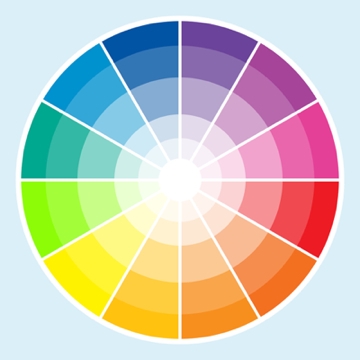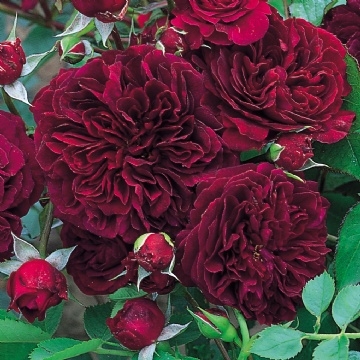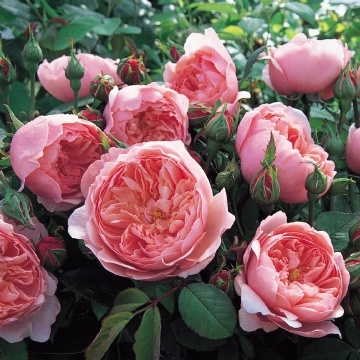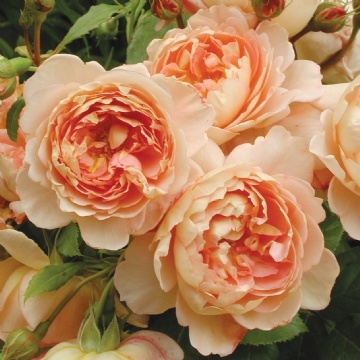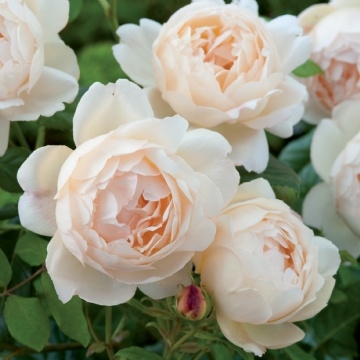Choosing This Year's Roses
-- By jannike petrovska --
No. I'm not obsessed with roses. In fact, the gardens I design for myself are composed of shaped hedges, artistic foliage, and subdued color, with an almost stark absence of blooms. But I'm imagining a new garden for Humpty Dumpty House Foundation, and I have to admit, some of the Romanticas, and many of the English roses, with their delicious fragrances, sky-high petal counts, and dreamy deep chalice shapes take my breath away. Regardless, I find designing with roses a challenge. Even when narrowed down to the Romanticas and English roses, there are oh-so-many choices. And unless you enjoy looking at thorny canes with bloomless or disease speckled foliage, "the right rose in the right place" is critical for superb performance. So for the past several years I've been collecting information about the best roses for a hot, dry southern California climate. Factors important to me were bloom power, color, disease resistance, form, and fragrance, in that order of priority.
,
Bloom Power: For sheer bloom power (with highest being a shrub smothered in roses year round), I've found Iceberg to be a rose that consistently delivers in our hot, dry area. But since I prefer quality to quantity, I hoped to find a stunningly beautiful, fragrant, disease resistant rose with enough repeat to keep at least a few blooms on the shrub most of the time, rather than an average rose with tons of nonstop blooms.
Color: The relationship between colors is one of the most important aspects of design, and color scheme can set the mood for a garden. I wanted this garden to be contemplative yet playful, and felt I could accomplish this with a harmonious color story, but one that wasn't too sleepy. Harmonizing colors are those next to each other on the color wheel; green, blue, violet, for example, or orange, red, pink. Each color contains elements of its neighboring colors, and like good neighbors, adjacent colors often work well together in a quiet way. Finding at least three harmonious colors was my goal. A deep burgundy red representing love, devotion, and soulful introspection. A pretty pink with an oh-so-slight hint of burgundy. And a pinky-apricot for a playful splash of fun. A perfect color triad for the mood I wanted to create.
Disease Resistance: I wanted to grow vigorous, bloom-packed shrubs without the application of fungicides and pesticides, so finding disease resistant varieties was important.
Form: The deeply cupped and chalice shaped blooms found on many of the Romanticas and English roses is heartbreakingly beautiful to my eye, so I was willing to sacrifice sheer bloom power for awe-inspiring beauty.
Fragrance: I wanted the garden experience to be fully immersive, so only roses with fragrance were considered.
Armed with this list of priorities, I began my search. And after reading everything I could find, talking to rosarians and rose enthusiasts, and visiting public and private rose gardens, here are my choices for the new rose garden at Humpty Dumpty House.
1. Tradescant. I wanted a deep burgundy-red, preferably with canes long and flexible enough to wrap around an eight foot long horizontal support, or to climb an arbor. Colorwise, I knew this would be the hardest rose to find, so I searched for it first. My experience with deep red roses is that in hot weather many of them bleach out to a pink. That would topple the triad of harmony I was trying to build, and leave my color scheme flat. Chocolate Sundae and Rouge Royale are two deep red roses that hold their color well. And Chocolate Sundae, though it's not a Romantica or an English rose, does have a lovely chalice shape, albeit with a lower petal count. I've been growing several Chocolate Sundaes in what should be ideal conditions, and I find it to be a stingy bloomer with no scent, otherwise it would have been a strong contender. Rouge Royale gets mixed reviews from rose enthusiasts, who either rave or complain about its repeat bloom and disease issues; people seem to love it or hate it. But I've been watching Rouge Royale in a garden where I work, and I've seen it with at least one or two blooms nearly nonstop, even through our brutal Sunset Climate Zone 21 summers. So Rouge Royale was second runner-up, but didn't win a spot in the new rose garden due to its short, rigid canes. Tradescant's canes are rigid as well, but they grow much longer, and Tradescant's color is even more striking than Rouge Royale's. Other roses that were considered for their good qualities include Prospero, The Prince, Dark Lady, LD Braithwaite, Falstaff, and William Shakespeare 2000. Of these, William Shakespeare 2000 gets outstanding reviews from people who grow it, but it tends to be a short rose, and the color can fade to pink in hot sun. Although not everyone who grows it reports Tradescant as a prolific bloomer, it gets good to excellent marks for bloom power, and very high marks in every other category.
Summary for burgundy-red roses in our hot, dry climate:
First place: Tradescant.
The best thing about Tradescant: People who grow it say it has a color not to be believed, and in hot sun it bleaches less than many other red roses.
The worst thing about Tradescant: Rigid canes.
Runners-Up: Rouge Royale, Chocolate Sundae, William Shakespeare 2000.
2. Alnwick. There are so many drop-dead gorgeous pink Romanticas and English roses that trying to choose one made me dizzy. Thank goodness I was looking for a specific pink. The roses that got excellent marks for heat tolerance, beauty, repeat bloom, and disease resistance were Scepter d'Isle, Sharifa Asma, Alnwick, Queen of Sweden, Yves Piaget, and Ingenious Mr Fairchild. I narrowed my choices to Alnwick, Queen of Sweden, and Scepter d'Isle because of their incredible beauty, and because the first two hedge well. If I hadn't discovered that a rose I'd been swooning over for nearly a year was actually Alnwick, I probably would have had to flip a coin. I observed Alnwick perform through a miserably hot, dry summer. I liked that Alnwick's canes were long, thin, and flexible so they could easily be wrapped around a support. And the blooms left me speechless. As you can see from the pictures, Alnwick's pink is perfect with the deep burgundy of Tradescant.
Summary for pink roses in our hot, dry climate:
First place: Alnwick.
The best thing about Alnwick: The sheer beauty of its blooms, and its ability to form a hedge.
The worst thing about Alnwick: Some people who grow it claim it burns, but the one I observed did fine in full morning sun, and dappled afternoon sun, even in the summer.
Runners-Up: Scepter d'Isle, Queen of Sweden.
3. Carding Mill. In the category of apricot colored roses tinged with pink, Carding Mill won hands down. There were numerous raves about its heat tolerance, great performance in hot, dry climates, and lovely form. One person stated that it bloomed continuously throughout the heat of the entire summer. Of all the roses I checked into, Carding Mill was one of only a few that got no complaints other than a few mentions about its weak fragrance. Other roses with similar coloration that got excellent marks include St Cecilia, a paler apricot, and Abraham Darby, which was frequently characterized as a "blooming machine" with "incredible fragrance". Abe Darby, especially in heat, seemed tinged with a bit too much yellow for this particular garden, and for me, its form isn't quite as pleasing as that of Carding Mill, but it's definitely a rose I'll be looking to use.
Summary for apricot roses in our hot, dry climate:
First place: Carding Mill.
Best thing about Carding Mill: Lovely chalice shape, and performs exceptionally well in hot sun.
Worst thing about Carding Mill: Fragrance reported to be weak.
Runners-Up: St Cecilia, Abraham Darby
4. Wollerton Old Hall. While visiting a nursery, I stumbled upon Wollerton Old Hall, a soft, cream-colored rose tinged with the palest hint of apricot, and I couldn't resist using it as a counterbalance to the dark, moody burgundy of Tradescant. It's a fairly new rose, but in early reviews, some people are calling it "the most beautiful, most fragrant rose ever", and others are saying "it's washed out and boring", which brings out an important point . . .
What we love is deeply personal. Our gardens: an expression of what we love. Stunningly beautiful roses? Ooh la la.
Go out; look at lots of roses -- and take home the ones that sing to your heart.
